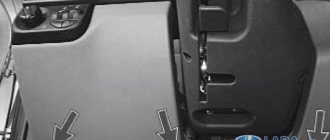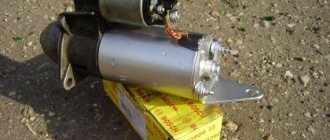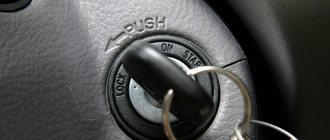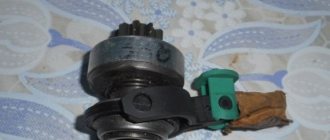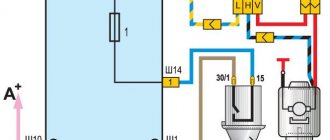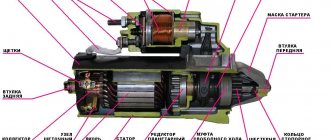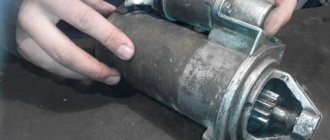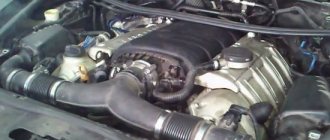VAZ 2107 starter does not turn: what to do?
The situation when there is no reaction when turning the key in the ignition switch is known to almost every motorist, especially owners of domestic models. If the instrument panel lights up, then the problem is not with the battery, but perhaps with a device such as the starter. We are interested in the starter on the VAZ 2107, but since these devices are identical on almost all domestically produced cars, this means that they have the same problems with malfunctions. If the VAZ 2107 starter does not turn, then it’s time to carry out diagnostics and find the breakdown. Let's figure out why the product for starting the engine may not function.
The starter turns for a long time when starting the engine
Starting an engine is a serious task, the competent solution of which requires compliance with a lot of conditions. Ideally, the starter should start the engine a couple of seconds after turning the key, but in practice it is often different. Sometimes starting the engine can take several tens of seconds and does not occur after the first turn of the key. If you have to turn the starter for a long time to start the engine, there may be several reasons for this. It is important to identify the malfunction and eliminate it, otherwise it is fraught with serious consequences.
Troubleshooting
If you operate a car for a long time without carrying out diagnostics and technical inspections, then everything will end in failure. If the engine does not start, then this breakdown can be repaired in a few minutes or in a few hours, depending on the type of breakdown. How can you determine why the starter does not turn? The main types of breakdowns include the following factors:
The simplest but most common breakdown of the starter on the VAZ 2107 is oxidation of the contacts. Moreover, the contacts oxidize both on the device itself and on the battery.
A more complex breakdown is usually associated with a malfunction of the solenoid relay, as well as rotor wear, breakage of windings, brushes and slip rings.
Burnout of the solenoid relay contacts. The exact breakdown of the mechanism can be determined after its dismantling. After removing the unit, you should check the condition of the main components, both the solenoid relay and the device itself. The resistance of the windings, the presence of breaks or short circuits, the presence of oxidation, contacts, etc. are checked. Once the cause of the breakdown is identified, it should be eliminated if possible, or the entire mechanism should be replaced.
The main reasons why the device does not spin
Let's consider the main reasons for such consequences in which the starter does not function.
The battery is low. It is very easy to identify such a breakdown. If you turn the key in the ignition, and there are no signs of life in response, and the lights on the panel have completely gone out, then the reason lies directly in the battery. The problem can be corrected by charging the battery. If the battery has a weak charge, at which the control panel operates, then when you try to start the engine, clicks of the relay operation will be heard.
Lack of ground on the solenoid relay. The mass can disappear for several reasons: contact oxidation, wire breakage, loosening of the nuts. If there is no “mass”, then the unit may not show any signs of life, or may work only once in a while. The situation can be corrected by stripping the contacts and tightening them, or by checking the supply wires.
Break in the circuit. If the relay does not click after trying to start the engine, then the failure may lie in the ignition contact group. The fault can be determined by checking the presence of contact between the ignition and the starter.
Solenoid relay malfunction. A malfunction of the solenoid relay can be eliminated by replacing it or, sometimes, repairing it.
The malfunction may also consist of a broken wire between the solenoid relay and the starter relay, through which power is supplied when the key is turned in the ignition switch.
How to recognize malfunctions
The starter should not be blamed if the engine does not start for the simple reason that the fault may lie in other devices. The malfunction of the device in question on the VAZ-2107 can be identified by the following signs:
- The car does not start, but the starter is buzzing. The reason is a malfunction of the retractor mechanism.
- Silence from the starter when turning the key in the ignition.
- The engine starts after several unsuccessful attempts to start it.
- The device continues to function after the engine is started.
- The presence of noise, grinding and knocking when the car is moving.
The presence of one of the above-mentioned signs indicates that the fault must be sought in this mechanism.
Unit repair
The estimated service life of the product is about 5-6 years. If the mechanism is used significantly, it should be replaced with a new one. You can check the serviceability of the solenoid relay by applying power to the product. The “+” power from the battery is connected to terminal “50”, and the “ground” is supplied to the unit body. If the product is in good working order, a quick and loud click will be heard. There will be no click on a faulty device. You can replace only the solenoid relay, but first carry out a full diagnosis.
Common Causes
Before checking, it is worth conducting a simple test for the operation of the starter, namely, checking its performance in cold and hot conditions. Based on this feature, you can exclude a lot of possible causes of problems. To check, it is enough to test the mechanism on a cold car, then start it and warm it up. Next you need to perform the same test.
Among the common problems it is worth noting:
- insufficient battery charge;
- thick oil;
- wear of bushings or brushes;
- problems with the solenoid relay;
- bad mass;
- Bendix failure;
- loose contact between brushes and commutator;
- short circuit of the element winding to ground.
The first point is the most common. Insufficient charge causes problems with the operation of the starter, due to which it cannot spin the shaft normally - there is simply not enough traction. Therefore, it is necessary to carefully examine the circuit with a multimeter. The check should affect not only the battery, but also all wiring elements.
The second problem is observed in cold regions when thick summer oil is used in the car. It is not designed for low temperatures, which is why it hinders the operation of various connections, including the crankshaft. In addition, during cold operation, the efficiency of the battery decreases, which also affects the operation of the starter.
Important! If the problem is thick oil and low temperatures, then a hot start should resolve the problem. Otherwise, that is not the problem.
Next comes wear on the bushings or brushes. Often the device wears out evenly, so this sign is a hint at replacing the starter. Damaged parts can be replaced, but other damage may occur.
Solenoid relay problems are also a common cause of starter problems. This is often due to the socket contacts, so it is important to have them checked immediately and replaced as necessary.
Often problems with the starter arise due to the “mass” of the battery. It is important to check its contact to the solenoid relay, as well as the integrity of the wires. If it shorts to the windings of the elements, this significantly reduces the efficiency of the device.
Breakage of the bendix, loose contact of the brushes and commutator, as well as some other reasons for the incorrect operation of the starter should also be checked in the process of solving the problem. It is only important to note that some problems occur only in a cold or hot system. This is also worth considering.
What to do if the starter clicks but does not turn on a VAZ-2107
Drivers of a VAZ-2107 car have probably at least once encountered a situation where, when turning the ignition key, nothing happens, the car is “silent” or clicks are heard. This happens when the starter (the device that starts the car) fails. Perhaps this situation will drive some people into panic, but there is no need to worry. You just need to contact a car repair shop or deal with the breakdown and carry out the repair yourself. In our article we will discuss in detail what such a malfunction could be, what you need to have in stock for repairs, and how to carry out such work yourself.
VAZ 2107 won't start
Every car owner should know the solution to this problem; this is very important. The car may refuse to start either on the highway, somewhere in the forest on a picnic, or in the garage at home. And it’s not always possible to call someone for help or take the car to a service station. Plus, if you ask someone to help, it will take up your time and money. Therefore, every driver should be able to solve this issue himself. So, our problem is the following: VAZ 2107 will not start. Before describing the search for a problem, you need to decide: do you have an injector or a carburetor?
Does not start
The VAZ 2107 with a carburetor was produced at the very beginning of the production of this car since 1982; an injector began to be installed on newer cars starting in 1994. Naturally, troubleshooting is very different. If we are dealing with a carburetor, then again we need to decide on the ignition system. VAZ 2107 was produced with both contact and non-contact ignition systems. The contact ignition system has a breaker-distributor in the distributor, the non-contact ignition system has a switch with a Hall sensor. It is very important to immediately decide on the ignition system, because the very first thing we will look for is a spark, but first things first. Procedure: 1) The very first thing you need to pay attention to is whether the starter turns the engine. If the starter turns the engine vigorously, go straight to the second point. If the starter does not rotate when you turn the ignition key, the following reasons are possible:
VAZ 2107 under the hood
1a) The battery is dead, or there is poor contact in the battery terminals. A dead battery is checked using a multimeter. The voltage of a charged battery should be about 12.8 Volts. If the battery voltage is less than 11.2 Volts, then the battery needs to be charged. Poor contact of the battery terminals is visible as oxide on the contacts. In this case, the terminals are removed and cleaned with sandpaper. 1b) If you hear a click when you turn the key, but the starter does not turn, this is the starter solenoid relay. Check that all wires are connected to the starter and that they are securely fastened. If you don’t hear any sounds at all when you turn the key, you need to check why the solenoid relay is not working. In any case, if the starter does not turn, then you should try to push start the car: turn on the ignition and try to put it in third gear while the car is rolling. If the problem is with the starter or solenoid relay, then the car will start. 1c) Problems with the contact group of the ignition switch, that is, when you turn the key, the ignition switch does not close the necessary contacts and the electric starter control circuit is not assembled. 2) If the starter turns the engine vigorously, you need to check the spark from the ignition coil. To do this, remove the central wire from the distributor, bring it to ground and rotate the engine. A spark should jump from the wire to ground. If there is a spark, we immediately go to point 3. If there is no spark, then we remember the question at the beginning of the article: is the contact or contactless ignition system set to seven? 2a) Contact ignition system. It consists of a distributor with a distributor-breaker and an ignition coil. We remove the cover from the distributor and turn it with the starter - the slider should run. If the slider stays still, it means the timing belt is broken. On the first models there was a chain drive instead of a belt, but then they began to install a belt. If the slider is spinning, then: — We check the ignition coil by checking the continuity of its primary and secondary windings. A detailed check is described in the article “Checking the ignition coil”. — We check the correct operation of the breaker-distributor. — We are changing the distributor breaker capacitor. If it fails, sometimes a spark remains, but it is too weak. Sometimes there is no spark at all. — We check the presence of voltage at contact B of the ignition coil. If it is not there, we find out the reason for the lack of power to the ignition system. — If there is a spark on the central wire of the ignition coil, but there is none on the spark plugs, then the slider resistor is broken, or the distributor cover contacts need to be cleaned. 2b) Contactless ignition system. The contactless ignition system consists of a switch, an ignition coil and a Hall sensor. — We check the Hall sensor. We take it out of the distributor, turn on the ignition, and use a knife to insert and remove it into the gap of the Hall sensor. A spark should appear on the center wire of the ignition coil. If there is no spark, then this does not indicate a malfunction of the Hall sensor; you need to look further. — The switch is checked only by replacing it with a new one. We exchange it for a new one, or one borrowed from a friend - a spark appears, which means the problem was in the switch. — We ring the ignition coil as described above. — We check the presence of voltage at contact B of the ignition coil. If it is not there, we find out the reason for the lack of power to the ignition system. — If there is a spark on the central wire of the ignition coil, but there is none on the spark plugs, then the slider resistor is broken, or the distributor cover contacts need to be cleaned. 3) There is a spark, but the VAZ 2107 does not start, which means fuel is not entering the carburetor. Remember, is there fuel in the gas tank? Fuel system check required:
The starter clicks but doesn't turn over
In most cases, if when you turn the key the engine does not start, but only clicks are heard, the reason must be sought in the solenoid relay. Although there may be other malfunctions, for example, damage to the wires or others, for example:
- The battery is dead. Sometimes it happens that the problem is not in the starter at all, but in the battery, which is discharged and simply does not have enough strength to start the engine. In this case, nothing will click; rather, a repeated cracking sound will be heard. This cannot even be called a breakdown; the battery is either recharged or the battery in it is replaced.
- The positive terminal has contacts in poor condition. It is necessary to inspect the clamps on the battery, and if they are oxidized, they need to be cleaned. One of the cables from the positive terminal goes directly to one of the contacts of the solenoid relay. Accordingly, if it is in poor condition or oxidized, the system will malfunction and “click”, but in such a situation this is not the most serious problem.
- Poor contact at the relay. The starter also has wires that can oxidize. The reason for this is the long mileage. They must be disconnected, inspected and, if necessary, cleaned.
- Poor ground contact. The terminal with a minus sign is connected to ground, and if the wires are oxidized on the terminal side or at the point of contact, this can also cause a breakdown. And again, everything needs to be cleaned.
- Solenoid relay. This type of malfunction occurs quite often. When you turn the key, nothing happens, you just hear clicks. When you turn it several times, the engine will, of course, start, but in this case the relay must be replaced with a new one, since this is the cause of the breakdown.
The bendix teeth or the flywheel crown may be broken. In such a situation, not only clicks will be heard, but also a crunching sound under the hood of the car.
What to do if the starter spins for a long time when starting the engine
Despite the fact that starting the engine falls almost entirely on the starter and battery, we must not forget about other elements that are involved in solving this problem. The following are the most common reasons why the starter spins for a long time when starting the engine:
Dirty fine fuel filter. If low quality fuel is used or various debris gets into the gas tank - sand, dust, stones, then over time the fine fuel filter will become clogged. This will lead to difficulties in the flow of fuel into the combustion chamber, which will cause difficulties when starting the engine and its operation. In such a situation, you need to change the fine filter to a new one and clean the gas tank from accumulated contaminants;
The above are the most common problems for any type of engine, but we can also highlight characteristic malfunctions for injection and carburetor engines.
The starter spins for a long time on an injection engine
A typical problem with an injection engine, due to which it takes a long time to crank the starter to start the engine, is an error in the on-board computer. This problem can be solved in two ways:
- By reflashing the on-board computer at a service center (or resetting errors);
- Resetting the on-board computer memory by disconnecting the battery. It is necessary to remove the wire from the negative terminal of the battery for 15-20 minutes so that errors are automatically deleted from the memory of the on-board computer, if they were recorded in it.
The starter hums, but the engine is silent
In this case, the cause of the breakdown is the bendix (it does not click).
And the buzzing is heard due to the fact that the anchor gets caught on the flywheel, and the launch does not occur. The starter works, turning the armature at high speed, but the engine flywheel does not spin up. Note: when the eccentrics stop functioning normally, the bendix begins to spin in different directions (should only go in one direction), and the gear rotates in the flywheel splines. And the result is a buzzing sound.
If you try really hard, in theory you can repair the gear, but it will be expensive, it will be difficult to find the eccentrics, and it may simply not be possible to put everything back together. In such a situation, it is more advisable to replace the entire assembly by first removing and completely disassembling the starter.
Take care of your car, carry out repairs in a timely manner, and it will serve you for as long as possible.
Why does the starter click but does not turn on a VAZ-2107
A person quickly adapts to any conditions, and especially to comfort. If you actively use your car, and then suddenly, due to a malfunction, send it to a technical center for repairs, you are left with no hands. But even worse is the situation when the car suddenly stops starting, even though everything was working perfectly yesterday. When you turn the ignition key, the starter clicks, but does not turn, and your VAZ-2107 stands rooted to the spot. For a novice car owner, this can be a real reason for panic, and for an experienced one, it can be another reason to get under the hood of an iron horse.
Starter malfunction
If a click is heard after turning the ignition key, but the engine does not start, then, as a rule, the cause of the breakdown is the unit itself. If one click is heard, then the charge required for ignition is reached, since the relay clicked. So the problem is not with him. The cause may also be an unstable charge, which is not enough to ignite.
In such a case, it is advisable to try to start the car several times at intervals of half a minute. Sometimes this helps, but if the issue is not resolved, then you need to check the elements for malfunction:
- bendix;
- retractor unit;
- winding for open circuit;
- check if the winding is short-circuited;
- The bushings and brushes were worn out (then you just need to replace these elements).
Why does this happen
The reasons for this behavior of the starter can be several factors.
For those who may have forgotten, let us remind you: the starter is an electric motor with a short period of operation and, by definition, it is easy to assume that it is not intended for long-term operation. During braking, it engages with the flywheel, drawing voltage up to 350A. That is why, when forced to work for a long time, the device malfunctions.
The click that is heard when the starting mechanism supposedly breaks down does not actually belong to it, but to its traction relay. The latter has a pair of windings - one is designed for holding, the second for retraction. When the relay clicks, it is due to the following. One stroke of the appropriate purpose draws in the core. But a voltage deficiency develops in the holding winding, and the pull-in winding misses the core.
And so the process is repeated several times while the key is in the “starter” position.
Since the traction relay in any model is identical, the brand of the car does not matter: VAZ, KIA or even BMW - the principle is the same for all.
A working mechanism starts up on the second attempt at most, but mostly on the first. If it's broken, it won't start at three. Therefore, you should not mock the engine until the battery runs out.
Situations in which the starter clicks but does not turn
Multiple and frequent sounds in the device:
- insufficient charge in the battery - check the charge current;
- Incorrect weight of the body with the engine - duplicate the weight with an additional drive;
- There is unstable contact at the battery terminals.
Single sound in the device:
- contacts are burnt - disassemble the device and then clean the contacts;
- check the engine mass;
- check the reliability of the starter latch with the traction relay;
- The starter is broken - you can only determine for sure after disassembly.
Circumstances associated with this behavior of the starter:
- the wire leading to the relay was burnt;
- brushes are worn out;
- anchor jammed;
- the winding is short-circuited;
- the winding is broken;
- broken or deformed fork with bendix drive;
- Bendix teeth clogged;
- Bendix is broken.
To determine the breakdown, it is enough to use an autotester to determine the voltage level of the starter power bolt, to which direct current from the battery is applied.
Then transfer the probe of the device being tested to the connection bolt at the starter output. You will need an assistant who will turn the key to the “Start” position at this moment. The following scenarios are possible:
- For example, at the input the tester showed 13.2 V, which indicates a fully charged car battery, and a similar voltage was obtained at the relay output. This means that the contacts are working properly, and, most likely, the cause of the problem lies in the starter itself.
- If the battery input is 13.2 V, and when the relay is activated there is a click and a voltage of 5-6 V, the bolts of the retraction element are burnt, which is why all the voltage is transferred due to poor contact.
What to do if the starter does not turn over?
Reliable engine starting in a car depends on many factors and, first of all, on the serviceability of the mechanisms. The VAZ 2107 is equipped with an electric starter, which turns the engine flywheel through a movable overrunning clutch. Among drivers it is often called Bendix. Starter failure can be caused either by malfunctions of its individual parts or components or by a simple discharge of the battery.
Typically, a similar situation occurs in winter or after a VAZ 2107 has been parked for a long time in an open parking lot or garage. Characteristic signs are clicking sounds of the starter solenoid relay, slow rotation or its complete absence. Troubleshooting involves charging the battery using a special device. After installing a new battery, it is easy to verify that the starter works well and spins the engine.
Troubleshooting
Long-term operation of a VAZ 2107 car can lead to failure or breakdown of individual components and mechanisms. How to determine why the car starter does not turn? Possible reasons for the mechanism to not work are as follows:
- Oxidation of contacts directly on the device, damage to the battery ground wire.
- Failure of the starter solenoid relay, breakage of the rotor windings, deterioration of brushes and slip rings.
- Breakdown of the solenoid relay, burnt contacts.
It is possible to determine exactly why the starter failed on a VAZ 2107 car only after dismantling and disassembling. It is much more difficult if the device either turns or does not work at all when you turn the key in the ignition. Such faults are diagnosed with great difficulty and usually, after fruitless searches, the unit is simply replaced with a new one or one that is known to be operational.
Diagnostics
If the problem is not initially found, it is worth diagnosing the starter by disassembling it. To do this, you must first remove it from the system and carefully examine it.
Important! It is recommended to work on the car only when the system is cold. You also need to first disconnect the starter from the power supply before working with it.
During the removal process, it is worth checking adjacent parts. It is especially recommended to inspect the retractor relay, because this is where problems can arise. If there are oxidized contacts at the connection points, you need to clean them. It is also worth checking all connections for oxidation, because inappropriate operating conditions can cause destruction of the metal. This leads to wiring problems.
Next you need to grab the starter again. The following elements are checked in turn during the analysis process:
- bushings and brushes;
- armature winding;
- stator winding;
- bendix.
The remaining elements are not so important, because checking them is difficult, breakdowns often occur due to these parts. It is important to carefully diagnose their condition and interaction with other elements in order to detect possible traces of problems.
In particularly severe cases such as massive oxidation, destruction of several parts and other malfunctions, it is recommended to completely replace the starter. Even after repair, the reliability of such a device will be low, and a comprehensive repair will be more expensive than purchasing a new part.
Removing the mechanism
The work of dismantling the device from the engine of a VAZ 2107 car will be carried out using the following tool:
- a set of open-end and ring wrenches;
- set of heads with a knob;
- flathead and Phillips head screwdrivers.
Once you are finally convinced that the electric starter is faulty, or rather that it does not turn the crankshaft, you can begin dismantling.
The sequence of operation performed by the wizard is as follows:
- Open the hood, disconnect the terminals from the battery and remove it from the engine compartment.
- We disconnect the starter, which does not turn the engine from the on-board network.
- Using a “13” key, unscrew the bolts securing the mechanism in the engine cylinder block.
- Carefully push the device out of the socket and remove the starter from under the hood.
In order to determine the exact cause of the malfunction of the engine starting mechanism on the VAZ 2107, it should be disassembled. The main purpose of such an operation is to detect defects in starter parts and assemblies through visual inspection. It is recommended to use a multimeter to check electrical circuits. If the car starter does not work well and intermittently, disturbances in circuits and contacts are possible.
How to repair a VAZ-2107 starter yourself
To begin with, it should be noted that on cars such as the VAZ-2107, the manufacturer can install starters of various types. Essentially, they perform the same function, but may differ slightly from each other in terms of design. Also note that the starter is a special mechanism that generates direct current, while creating the torque necessary for the crankshaft to start rotating.
Starter components
To repair a part of any device, you need to understand what it consists of. So, for example, the design of the starter is as follows:
- anchor;
- frame;
- drive unit;
- relay. Connection to it is made using contact bolts, which are considered structural elements. Each of them consists of parts that are fairly easy to replace if necessary.
Remember that it is quite easy to repair the starter on a VAZ-2107 with your own hands. To do this, you need to know what exactly it consists of, as well as what it is intended for.
Where to start repairing the starter
Before you begin repairing the starter, you need to find the source of the problem.
troubleshooting
In order to correctly determine where to start, you should think about what could be the reason that the starter does not work:
- If, after you turn the key in the ignition, the engine stubbornly refuses to start, you should check the light bulbs located on the instrument panel. If they burn weakly or go out completely, most likely the reason lies in a non-functioning battery. Or it may simply be discharged. We pick up a tester and check the battery capacity and voltage;
- if the battery is fully operational, you need to check what position the speed switch is in and move it to the “P” position;
- The next thing to figure out is whether the power from the ignition switch is getting directly to the starter.
There are two ways to do the last step.
Method 1. A wire made of copper with a cross-section of 2.5 mm is inserted into the open connector. One end goes to the starter and the other to the battery terminal. Thanks to this method, it is possible to simulate ignition.
Method 2: This verification method will require two people. One of them will turn the key in the ignition switch, while the second will touch the tip of the wire that comes from the unloading relay with a control probe. If the warning light comes on during this procedure, this indicates that there are no problems in the ignition switch, as well as in the relay.
Starter repair
As you know, VAZ-2107 cars are equipped with both injectors and carburetors. In this regard, the sequence of actions and the repair work on the starter itself may differ slightly from each other. However, no matter what your car is, it is quite possible to solve this problem yourself.
First of all, it is necessary to dismantle the starter. To do this, the car is installed above the inspection hole or raised on a lift. But first you should disconnect the negative terminal from the battery. Next, the procedure depends on what is installed on your car: carburetor or injector.
We repair the starter on a car with a carburetor engine
- Disconnect and remove the mass air flow sensor, as well as the air filter housing.
- We take a flat screwdriver in our hands and remove the rubber holders that secure the filter from the brackets.
- Disconnect the water intake from the filter pipe and remove it from the holder.
We repair the starter on a car with an injection engine
- We remove the mudguards, both main and additional. This action is impossible if you do not have a socket wrench size 8. Using it, you need to unscrew 4 screws that are located on the main panel, or rather, on its side and front fastenings, as well as 2 bolts located on the additional one. There is also a lower screw, but it has a different diameter. To remove it you will need a 10 mm socket wrench.
- Now, using a long 13mm socket wrench, unscrew the bolts that secure the clutch housing and starter. After this, unscrew the bolts with which the starter is attached directly to the bracket and the inlet pipe extension.
- We remove the stretch marks of the intake pipeline and very carefully, using the same wrench, unscrew the exhaust manifold nut, and then remove the shield.
- We disconnect the wire that we have left from the battery terminal and remove the tip located on the contact rod.
- The traction relay output must be freed from wire 50, and then the starter itself must be removed. Now it can be disassembled. Before doing this, try to thoroughly clean the part to remove any dirt stuck to it.
Once the starter is in your hands, the procedure is as follows (by the way, it is absolutely identical for any type of engine of the above car):
- check the solenoid relay. After connecting the 50th relay output to the “plus” terminal of the battery, we connect the starter housing directly to the “minus” terminal. This way, it will become clear whether the problem is in the relay itself or is it in something else. If it is in working condition, then a distinct click will be heard during this action;
- To check the integrity of the windings, you need to get rid of the starter cover and disconnect the brush assembly. Using an ohmmeter, check whether there is a short to the starter housing;
- if the results of our test showed that the relay still works, we take out the anchor. To do this, unscrew the bolts securing the starter casing, remove the lock washer, as well as the gaskets. Then unscrew the two nuts and completely remove the back cover. Thus, the starter winding housing is freed from the studs;
- unscrew the nut of the eccentric rotation axis and remove it from the body, disconnecting the armature.
At this point, the process of disassembling the starter can be considered complete. The anchor, by the way, cannot be repaired, but it can easily be replaced with a new one. Reassembling the starter is carried out in the reverse order.
Disassembling and checking the condition of the starter
First of all, the solenoid relay is removed from the mechanism and inspected. On a VAZ 2107 car, some malfunctions of the electric starter are associated with burning contacts.
Helpful advice: fixing this damage is quite simple; just clean the working surfaces with fine-grain sandpaper and sand them. In the vast majority of cases, the starter begins to function after this procedure.
Another reason for failure may be a mechanical failure of the overrunning clutch. If the starter of a VAZ 2107 turns easily with a characteristic buzzing sound and the engine does not start, then the bendix has failed. You can check it by turning the gear in one direction and the other; a working mechanism does not allow reverse rotation. After troubleshooting or replacing the starter, we perform a test run and check the functionality of the device.
What to do first?
Disassembling the mechanism is not a priority task, since the starter’s power supply is connected to the battery, so you need to start with it. If the car is not too old, it is unlikely that the problems will lie in the design of the starter itself. It is enough to clean the contacts of the battery or the device itself for everything to work again in the desired mode.
Difficulties begin when the machine has worked for a long time and its operation has not been delicate. If, after a complete check of the electrical equipment of your VAZ 2107, the starter still does not start or continues to work intermittently, then the reason is inside the device and it is necessary to remove and disassemble the starter. On this model, both in carburetor and injection versions, it is installed rather inconveniently. To get to it normally, you will have to drive the car onto an overpass or inspection hole.
Disassembling the VAZ 2107 starter
After the ignition is turned off, you can begin the “operation”. It must be done in the following order:
- remove the ground terminal from the battery;
- if there is a protective mud casing at the bottom, then it must be dismantled;
- remove the electrical wires from the solenoid relay;
- unscrew the three mounting bolts (two upper, one lower);
- remove the starter.
As you can see, nothing complicated. The only thing is that in the case of an injection model, mechanics advise removing the inlet pipe extensions as well. Now we have to disassemble the device itself.
